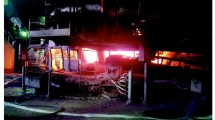Abstract
A secondary lead smelter produces several tons of bag-house dust a day. Appropriate handling of this dust is mandatory to meet the proposed OSHA and EPA workroom and ambient standards. Dust agglomeration proved a successful approach. Dusts with a high concentration of PbCl2, or compounds containing PbCl2 can be agglomerated at much lower temperatures than samples with low PbCl2 concentrations. The chlorine sources are polyvinyl chloride (PVC) battery plate separators. Since PVC is used in Europe to a much greater extent than in the U.S., the composition of feedstock must be considered in equipment selection at U.S. secondary smelters. The vapor pressure characteristics of PbCl2 favor its evaporation at blast furnace temperatures. Condensation occurs in the gas cooling system. Recycling of baghouse dust leads to a buildup of PbCl2 in the smelter. Its removal from the system is eventually necessary through leaching, if charges with a high PVC content are processed.
Similar content being viewed by others
References
Federal Register 43 (220) Tuesday, Nov. 14,1978, p. 52952.
Federal Register 43 (194) Thursday, Oct. 5, 1978, p. 46246.
R.T. Coleman and R. Vandervort, “Source Characterization of the SB Smelting Furnace,” Contract No. 210-77-0008, 1978.
R.T. Coleman and R. Vandervort, Demonstration of the Bergsoe Agglomeration Furnace and Best Management Practices at a Secondary Lead Smelter, Radian Report DCN 79-201-010-02, 1979.
T.S. Mackey and Svend Bergsøe, “Flash Agglomeration of Flue Dust,” J. Metals 29 (11) (1977), p. 12.
J.W. Mellor, Comprehensive Treatise on Inorganic and Theoretical Chemistry, Vol. 7, New York, Longmans, Green, and Co., 1927. p. 728 and 736.
Karl Keckan, Ford Motor Company, Battery Division, telephone communication, June, 1980.
F.C. Keller, East Penn Manufacturing Company, Inc., Lyons Station, Pennsylvania, oral communication, August, 1980.
Handbook of Chemistry and Physics, 59th Edition, CRC Press, 1978-1979, D-235—D-239.
Handbook of Chemistry and Physics, 59th Edition, CRC Press, 1978-79, B-129.
Author information
Authors and Affiliations
Additional information
Klaus Schwitzgebel received his BS and MS in chemistry and his PhD in materials science from the Technical University in Darmstadt, Germany. He started his career with Tracor, Inc. in 1967 and in 1969 joined Radian Corporation where he is presently assistant vice president. He has published numerous technical papers. He is a member of the Canadian Institute on Mining and metallurgy and received the ASME Award for the best paper advancing the engineering profession in 1978.
Rights and permissions
About this article
Cite this article
Schwitzgebel, K. Flue Dust Agglomeration in the Secondary Lead Industry. JOM 33, 38–41 (1981). https://doi.org/10.1007/BF03354399
Published:
Issue Date:
DOI: https://doi.org/10.1007/BF03354399




